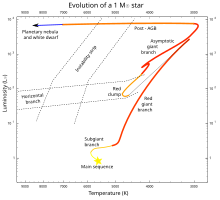RV Tauri star
RV Tauri stars are pulsating yellow supergiants whose light changes are characterized by alternating flat and deep minima with round maxima. They form a subclass of the Type II Cepheids .
properties
spectrum
The spectral class varies from F or G at maximum to K or M at minimum with changes in radial speed of 10 to 50 km / s. This is characteristic of pulsating stars . In the spectra of the RV Tauri stars, shock waves were detected in the supergiant atmospheres, which lead to a discontinuous course of the radial velocities. The presence of Balmer lines in emission , which are typical of early stars, and the titanium oxide bands in absorption , which are typical of late stars, make a determination of temperature and luminosity difficult.
Spectrographically, the RV Tauri stars have been divided into three classes:
- Class RVA: Spectral type G – K with strong absorption lines as well as CN and CH bands.
- Class RVB: RVB stars are warmer than the representatives of class RVA with pronounced CN and CH bands.
- RVC class: RVC stars show very weak absorption lines.
There is no connection between the classification according to the light change and the classification according to the spectrum.
In the infrared , a dust cover can be detected in many RV Tauri stars. The mass loss due to stellar winds estimated from the IR emission is in the order of magnitude of solar masses per year.
Change of light
The light change period of RV Tauri stars is measured from one deep minimum to the next deep minimum and is between 30 and 150 days. The amplitude can reach up to 4 mag . The light curve is used to subdivide into two subgroups:
- RVa: Alternating flat and deep minima at a constant brightness level
- RVb: A long-period light change, often in the form of a wave, with a cycle length of 600 to 1500 days is superimposed on the minima.
The changes in brightness are semi-regular. There is always a defined period, but the shape of the light curve is subject to changes in each cycle.
Cause of the light change
The light change is either a result of a 2: 1 orbit resonance . The first harmonic is only half as long as the fundamental , which spans the period between two deep minima. According to the second hypothesis , RV Tauri stars show low-dimensional chaos .
Occurrence in star catalogs
The General Catalog of Variable Stars currently lists about 100 stars with the abbreviations RV , RVA or RVB , which means that only about 0.2% of all stars in this catalog belong to the class of RV Tauri stars.
Development status

RV Tauri stars are ancient and rare stars. They show an infrared excess , caused by a strong stellar wind on the asymptotic giant branch (AGB). Either after a helium flash they are briefly off AGB on a blue loop, during which they cross the instability strip , or after the end of the AGB phase they transform from a red giant into a white dwarf . Both stages would be short astronomically and therefore an attempt was made to find period changes in RV Tauri stars to measure the speed and direction of evolution. However, the observed period changes correspond to random noise . The masses of the RV Tauri stars have been estimated to be about 0.7 to one solar mass.
The estimated lifespan of the RV Tauri stars is approximately 200 years. However, z. B. R Scuti since its discovery in 1793.
Hypothetical binary star nature
The superimposed light change the RVb subset could be one of the sequence coverage in a wide binary system be. The companion has stored material from the strong stellar wind of the RV Tauri star in a torus and this dust disk periodically covers the RV Tauri star. It has been suggested that all RV Tauri stars are formed in binary systems.
Examples
- RV Tauri , R Scuti
See also
literature
- C. Hoffmeister, G. Richter, W. Wenzel: Variable stars . 3. Edition. JA Barth, Leipzig 1990, ISBN 3-335-00224-5 .
- JR Percy: Understanding Variable Stars . Cambridge University Press, Cambridge 2007, ISBN 978-0-521-23253-1 .
- RA Arneson et al: A SOFIA FORCAST Grism Study of the Mineralogy of Dust in the Winds of Proto-planetary Nebulae: RV Tauri Stars and SRd Variables . In: Astrophysics. Solar and Stellar Astrophysics . 2017, arxiv : 1706.00445v1 .
